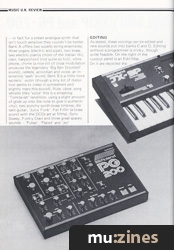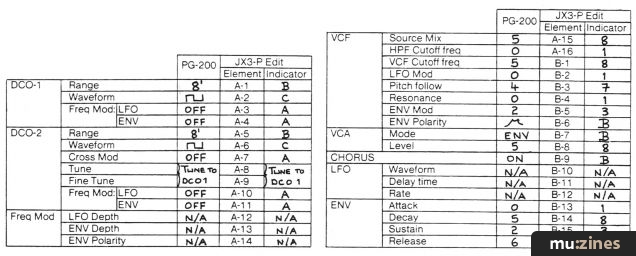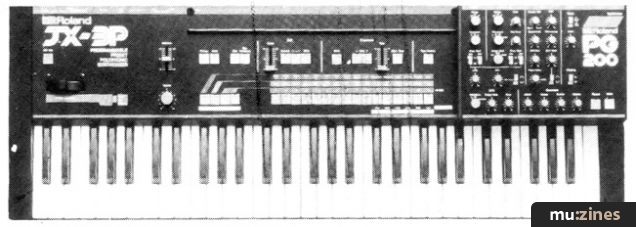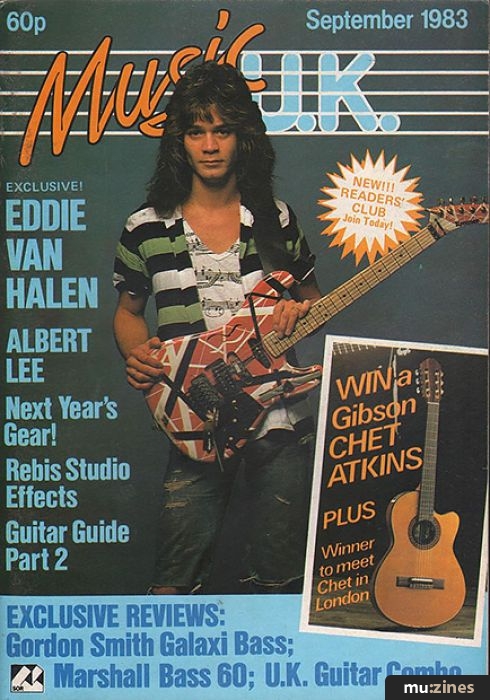Magazine Archive
Home -> Magazines -> Issues -> Articles in this issue -> View
Roland JX-3P and PG-200 | |
Article from Music UK, September 1983 | |
Dave Crombie tries one of today's biggest sellers. Just how good is Roland's latest?

I'm not at all sure why Roland call the latest of their poly-synths the JX-3P - it's a bit of a mouthful, and doesn't seem to refer to anything in particular. This is a preset voice assignable poly which, with the aid of a PG-200 programmer, can be turned into a fully programmable instrument. We're looking at both units, so one would be talking about an investment of £1,095 (£900 for the synth plus £195 for the programmer), which is £100 less than the Juno 60. All prices quoted are Roland's recommended retails. One might think that the JX-3P is competing with the Juno polysynths, and to some extent this would be right, but the JX-3P does approach the subject from a different angle, and accordingly can do some things the Junos can't, and vice versa.
So the JX-3P on its own is a six voice machine with 32 pre-programmed sounds which can be edited and then stored in a further 32 memory locations. To create your own voicings it is probably best, though not essential, to invest in a PG-200 programmer. The JX-3P is a fairly smart looking instrument — it has a five octave C to C keyboard, with a positive though not too firm action. The control panel has clean lines and looks pretty straightforward, but behind this apparent simplicity lurks a considerable density of control elements.
VOICE COMPLEMENT
The JX-3P uses 12 digitally controlled oscillators as signal sources for its six voices. Being digital, these have the advantage of always being perfectly in tune, and not prone to failure, but DCOs when used 'en-masse' tend to sound a little 'flatter' than analogue VCOs. This is because the DCOs' pitches all originate directly from a single source (the processor); consequently they have a fixed phase relationship with one another — though a pseudo-random phase biasing can be introduced via the software program used to run the machine to alleviate the problem.
Basically this all boils down to the fact that an instrument, if too perfectly in tune, doesn't sound as good as one with minor tuning discrepancies. Having said that, one need not worry too much on this score in the Roland's case because a) there's a stereo chorus circuit which adds considerable spatial depth to the voicings and b) the JX-3P has a good basic timbral character anyway. So there are two DCOs per voice, each capable of producing ramp pulse or square waves (DCO 2 can be switched to white noise mode for unpitched signal sources). These are then fed via a source mixer to the VCF, which offers 24dB/octave low pass filtering with modulation from the LFO or ADSR. Unfortunately there's only one such envelope generator per voice, but this can be inverted if desired to provide negative aperiodic filter modulation. This positive or negative envelope can also be applied to either or both DCOs for pitch modulation. There's a static high pass filter too to remove unwanted low frequency elements.
An LFO provides delayed sine, square, or random waves, whilst the VCA can be Gate or ADSR controlled. The signals from the various voices are then mixed together for final processing via the stereo chorus and master tone control. So a comprehensive set of voice circuits, which, with the exception of the single ADSR EG, is as much as one could expect or need.
PRESET SECTION
Twenty silver push button 'momentary' switches with LEDs are arranged in groups of 4 and 16 just above the keyboard. They are marked A, B, C and D, and 1 to 16. And, as you will have guessed, they are the preset and memory selectors. Banks A and B are the 32 factory presets, whilst C and D are user programmable memory locations.
The presets determine virtually everything, including whether the stereo chorus is switched in or not. These voicings are marked on the control panel, so you know what you are supposed to be getting — unlike some machines I could name! Now what about the quality?... Never mind the quality, hear the strings. The preset voicings are great — in fact for a preset analogue synth that isn't touch sensitive they couldn't be better. Bank A offers two superb string ensembles, three organs (electric and pipe), two brass, two electric pianos (more of the Italian ilk), clavi, harpsichord (not quite so hot), vibraphone, chime (a nice bit of cross modulation produces the legendary 'Big Ben Doorbell' sound), celeste, accordian and voice, an interesting 'aaah' sound. Bank B is a little more esoteric: violin (though a tiny bit of distortion seems to creep in somewhere and slightly mars this sound), flute, oboe, song whistle (like 'voice' this is a smashing 'Tomita-ish' rendition, using a slight amount of glide up into the note to give it authenticity), two punchy synth-brass timbres, distant guitar, 'Juicy Funk', Fat Fifth (a brass sound with the DCOs set at fifths), Sync Sweep, Funky Clavi and three great spacey sounds — 'Pulsar', 'Planet' and 'Jet'
EDITING
As stated, these voicings can be edited and new sounds put into banks C and D. Editing without a programmer is tricky, though quite feasible. On the right of the control panel is an Edit-Map. On it are depicted the elements that are used when constructing a sound — DCO pitch, waveform, filter cut-off frequency, etc. Each has a code number (A: 1 to 16 and B: 1 to 16). To edit a sound one has to select the parameter using this code, and then re-define it. This is done using the slider in the edit section. As this is advanced the LEDs on the 16 program switches light up in turn and these represent the value of the parameter, which can thus be set to one of sixteen levels. This is, therefore, an incremental system, and only one parameter can be changed at a time. When happy with the new sound, just write it into a spare memory in bank C or D.

THE PG-200
The PG-200 gets rid of all this fiddly manipulating of editing. It consists of a smallish box that is magnetically attached to the Edit-Map, featuring a series of knobs and switches that correspond to all the voice controls. It is linked to the JX-3P by a locking DIN connector, and this delivers power to the unit as well as carrying all the info. One can either use the programmer for editing existing sounds, or by hitting the 'manual' button, the PG-200's entire control network becomes active and one gets the sound that corresponds exactly to the settings of the knobs and switches — in this way voicings can be created from scratch.
The PG-200 is very useful, but I'm not sure whether it's £195's worth of usefulness.
SEQUENCER
I haven't finished though, because there's still the sequencer to discuss. This will process six note chords in step time with up to 128 note storage. To get around the step timings one has to tie notes together, which cuts down the memory available. Even so, it is still exciting to find such a polyphonic sequencer on an instrument selling at this kind of money.
ODDS AND ENDS
I haven't, as yet, mentioned the performance Controls. These consist of a pitch bend lever — horizontally mounted and centre sprung. Situated alongside this is an LFO trigger button which gradually introduces LFO modulation when pressed and held — this isn't as versatile a system as an actual modulation wheel or lever, but it is simple and effective.
A cassette interface will dump both sequence and program data onto a standard audio cassette, for future use. And of course the JX-3P has the new MIDI interface for linking up with other computer based hardware. Other rear panel connections include stereo audio output, headphone out, sequence trig in, and the cassette interface port.
What a machine! Nicely priced, a good sound — all you could ask for. Yet again, the Roland JX-3P demonstrates just how much good value equipment is on offer today, especially in this price area of the synth market. You wouldn't regret buying one of these! The PG-200? That would depend on how you planned to use your JX-3P.
Also featuring gear in this article
Polyphonic Synthesizers
(ES Dec 83)
Roland GR700 Guitar Synth
(12T Apr 84)
Patchwork
(EMM Jun 84)
Patchwork
(EMM Aug 84)
Patchwork
(EMM Oct 84)
Patchwork
(EMM Dec 84)
Patchwork
(EMM Mar 85)
Patchwork
(MT Feb 89)
...and 5 more Patchwork articles... (Show these)
Browse category: Synthesizer > Roland
Browse category: Synthesizer Accessory > Roland
Featuring related gear
Exploring New Territory - Gibson Explorer Synth
(EMM Dec 85)
Gibson Explorer Synth - Guitarcheck
(IM Feb 86)
The Guitar Link
(ES Jun 84)
The Guitarist's Revenge
(EMM Jun 84)
The Six-String Synthesizer
(IM Feb 85)
Patchwork
(EMM Jun 84)
Patchwork
(EMM Aug 84)
Patchwork
(EMM Oct 84)
Patchwork
(EMM Dec 84)
Patchwork
(EMM Mar 85)
Patchwork
(MT Feb 89)
...and 5 more Patchwork articles... (Show these)
Browse category: Guitar Synthesizer > Roland
Browse category: Synthesizer > Roland
Publisher: Music UK - Folly Publications
The current copyright owner/s of this content may differ from the originally published copyright notice.
More details on copyright ownership...
Gear in this article:
Synthesizer > Roland > JX-3P
Synthesizer Accessory > Roland > PG-200 Programmer
Gear Tags:
Review by Dave Crombie
Help Support The Things You Love
mu:zines is the result of thousands of hours of effort, and will require many thousands more going forward to reach our goals of getting all this content online.
If you value this resource, you can support this project - it really helps!
Donations for April 2024
Issues donated this month: 0
New issues that have been donated or scanned for us this month.
Funds donated this month: £7.00
All donations and support are gratefully appreciated - thank you.
Magazines Needed - Can You Help?
Do you have any of these magazine issues?
If so, and you can donate, lend or scan them to help complete our archive, please get in touch via the Contribute page - thanks!




















